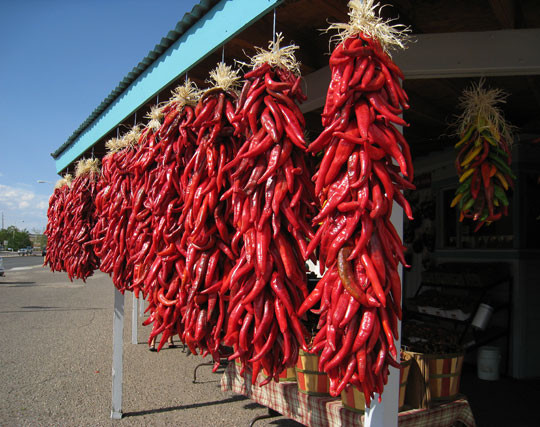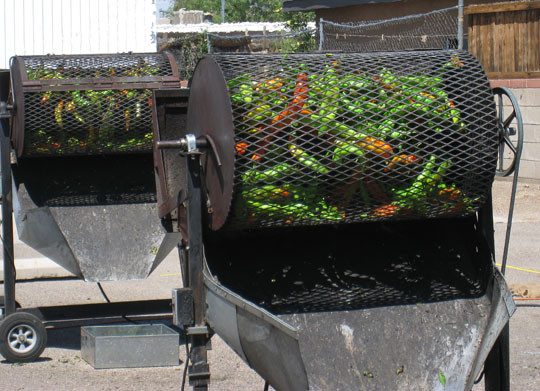Did you know New Mexico holds the unique distinction of having an official state question? That question is simply, “Red or Green?” In New Mexico, almost every restaurant serving local cuisine will ask you “Red or Green?” when you place your order. If you don’t hear this question, you might not be experiencing authentic New Mexican food, but perhaps Mexican or Tex-Mex instead.
Unpacking “Red or Green?”: The New Mexico Chile Choice
So, why this ubiquitous question? It all boils down to New Mexican dishes being traditionally smothered in either red or green chile sauce. Whether you’re ordering enchiladas, chile rellenos, huevos rancheros, tamales, stuffed sopapillas, or almost anything else on the menu, you’ll be prompted with “Red or Green?” This translates to: would you prefer your dish smothered in rich red chile sauce or vibrant green chile sauce? For those who can’t decide, there’s the option to order “Christmas,” receiving the best of both worlds with both red and green chile sauces. Personally, I lean towards green chile with chile rellenos, and red chile with tamales, carne adovada, and huevos rancheros, but for other dishes, I often go with whatever strikes my fancy in the moment.
New Mexico Chile, spelled with an “e” – a point of pride in the state – is the fruit of the Capsicum plant genus, thriving across New Mexico. While the exact arrival of chile peppers in New Mexico from Central America is uncertain, it’s widely accepted that Spanish immigrants introduced them starting in the 1500s. The most prevalent type grown in New Mexico is a long, slender green chile, resembling the Anaheim pepper. Over time, cross-pollination and hybridization have led to various New Mexico chile varieties, including well-known names like Big Jim, Sandia, Rio Grande, Joe E. Parker, New Mexico 6-4, and Heritage 6-4. Notably, smaller farms, particularly in northern New Mexico, cultivate indigenous heirloom seeds, preserving unique chile lineages.
Each New Mexico chile variety has its own heat range, measured in Scoville heat units. For instance, NuMex Big Jim chiles are generally considered medium heat (2,500 – 3,500 Scovilles), while Sandia or Diablo varieties can range from hot to extra hot (5,000 – 7,000 Scovilles). When purchasing New Mexico chile, you’ll typically find them categorized as mild, medium, hot, or extra hot, rather than by specific variety. Similar to other fruits and vegetables, the seed, soil, water, altitude, and climate significantly influence the flavor profile of the chile. (Scoville units information courtesy of Biad Chili Products)
Outside of New Mexico, chile peppers are often marketed as either New Mexico chile or Hatch chile. New Mexico chile can originate from anywhere within the state, whereas Hatch chile specifically comes from Hatch, New Mexico. It’s important to note that “Hatch chile” isn’t a specific chile variety itself. Instead, it refers to chile peppers grown in and around Hatch, New Mexico, encompassing a mix of varieties and heat levels. While “Hatch Chile” is widely recognized outside the state, not all New Mexico chile originates from Hatch. Although Southern New Mexico is a major growing region, chile cultivation extends throughout the state, reaching as far north as the New Mexico/Colorado border.
 New Mexico chile – red or green?
New Mexico chile – red or green?
New Mexico chile pods in red and green, showcasing the state’s iconic culinary question.
Hatch, NM, a small village in southern New Mexico, stands as a significant producer of New Mexico chile. The reputation of Hatch chile has grown so much that the village hosts the annual Hatch Chile Festival every Labor Day weekend. This festival attracts over 30,000 visitors globally, a remarkable feat for a village with a population under 2,000!
The Art of Cultivating New Mexico Chile
The majority of New Mexico chiles are harvested green, but some are allowed to mature on the plant until they turn red. Green chiles are typically roasted and peeled for creating green chile sauce or simply chopped for use in enchiladas, calabacitas, and countless other dishes. Green chile can also be dried and ground into green chile powder, adding another dimension to New Mexican cooking.
Red chiles can also be roasted and used fresh, similar to green chiles. However, they are more commonly strung into ristras and hung to dry, sometimes seen adorning rooftops across the state. New Mexico’s arid climate facilitates rapid drying. Once dried, red chiles are transformed into red chile powder or the base for rich red chile sauce. You can delve deeper into this in “New Mexico Red Chile.”
 Ristras of fresh New Mexico red chile @mjskitchen mjskitchen.com
Ristras of fresh New Mexico red chile @mjskitchen mjskitchen.com
Vibrant ristras of fresh New Mexico red chile peppers, a common sight in the region.
Roasting Green Chile: A New Mexico Tradition
Both fresh green and red chiles undergo roasting, peeling, deseeding, and chopping. In New Mexico, it’s common to purchase a bushel, approximately 30 to 35 pounds, of chile and roast it yourself or have the vendor roast it for a small fee. Opting for vendor roasting is recommended to save time and effort. Vendors typically use large, gas-powered roasters capable of handling a whole bushel in minutes. The chiles are placed in a rotating, grated drum over a gas burner, searing the skins evenly. After roasting, the batch is bagged for you to take home, cool, peel, and prepare for use or storage.
 New Mexico chile roasters
New Mexico chile roasters
Commercial chile roasters in New Mexico, essential for processing large quantities of chile during harvest season.
Home Chile Roasting Methods
For those wanting to roast chiles at home, it’s easily done on a grill or under a broiler. For detailed instructions, MJ’s Kitchen’s “Roasting Peppers on the Grill” and The Yummy Life’s “How to Roast and Peel Peppers” provide helpful guides for roasting, prepping, and storing your chiles.
Chile roasting season in the fall is a sensory delight, with the enticing aroma permeating the air. The roasting process is prevalent throughout New Mexico during this time. After roasting, the chiles are peeled, stems and seeds are removed, and sometimes the inner veins are also removed. These veins, the light-colored membranes inside the chile, contain most of the capsaicin, the compound responsible for the chile’s heat. Removing the veins reduces the chile’s spiciness. At this stage, the chile is ready for immediate use or freezing. Whole roasted chiles are perfect for chile rellenos, while chopped chile is incredibly versatile for countless recipes. Learn more about this versatile ingredient in “New Mexico Green Chile.”
Red vs. Green Chile Heat: A Matter of Variety
Regarding heat levels, it’s always best to taste before assuming. While there’s a common notion that red chile is hotter than green, it’s truly relative and depends on the specific chile variety. I’ve personally encountered incredibly hot green chile that could make you break a sweat! This is why honey is often found on tables in New Mexican restaurants. A touch of honey on a tortilla or sopapilla can help alleviate the burning sensation. Adding a small amount of honey to chile sauces or stews that are too spicy can also help balance the heat. However, moderation is key.
So, which is hotter – red or green? The heat intensity is determined by the chile variety – Big Jim, Sandia, Joe E. Parker, Diablo, etc. For example, Sandia red chile can be hotter than Sandia green, but both Sandia varieties are generally hotter than Big Jim red or green. You can always lessen the heat of any chile by removing the veins and pith inside. According to Cook’s Illustrated, the majority of capsaicin (heat) resides in the pith. (“Common Cooking Myths, Debunked – All parts of a chile are equally hot.” Cook’s Illustrated. September / October 2013)
When buying New Mexico chile, you’ll typically have options like mild, medium, hot, or very hot. We usually opt for medium with a few hot chiles mixed in. Interestingly, freezing roasted chile can intensify its heat. While the exact science behind this isn’t fully understood, the experience is undeniable. Personally, I prefer my chile with a noticeable kick, but not so overpowering that it masks the chile’s delightful flavor.
Final Note: New Mexico chile is truly addictive! To help you satisfy your craving, or your soon-to-be craving, this website offers numerous recipes and links featuring both green and red chile in various forms.
Explore More on New Mexico Chiles
Christmas – Red and Green
NM Red Chile and Red Chile Sauce
NM Green Chile and Green Chile Sauce
Further Reading and Recipes
Chile or Chili?
Green Chile Burn Video and recipe for a Quick and Easy Green Chile Stew
Green Chile Powder and How to Use it
Recipes that use Green Chile
Recipes that use Red Chile
Sources for New Mexico Chile Products
Website Copyright – Please respect the copyright for this website. The photos and text on this page and all other pages are copyrighted by MJ’s Kitchen.